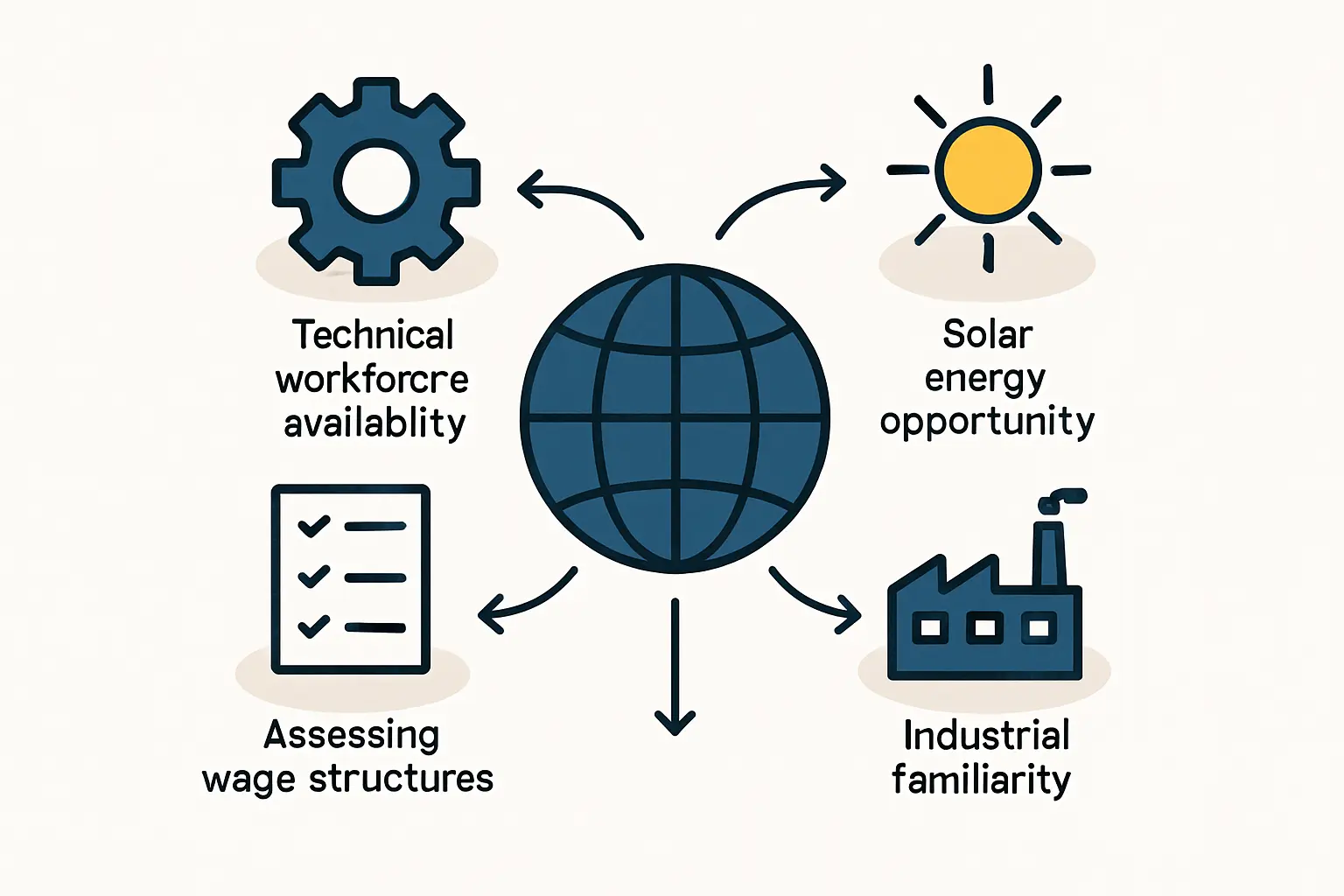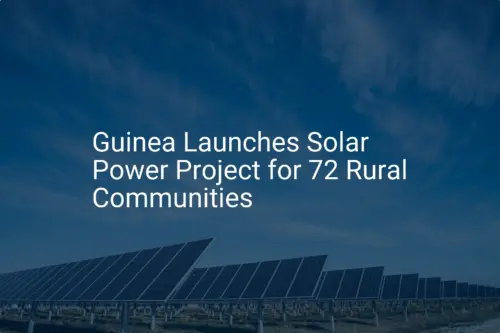When an entrepreneur considers establishing a solar module assembly plant in Guinea, the initial focus naturally falls on machinery, financing, and facilities. Experience shows, however, that the most critical factor for long-term success is the workforce.
While finding skilled labor in emerging markets can seem like an insurmountable challenge, the reality in Guinea is more nuanced. It presents a significant opportunity for investors who take a strategic approach to human capital. This analysis explores the Guinean labor market, detailing its demographic potential, prevailing wage structures, and the essential role of structured training in transforming a willing workforce into a highly competent technical team.
The Guinean Labor Landscape: Potential and Preparation
At first glance, Guinea’s labor statistics might seem challenging. The adult literacy rate is around 32%, but a deeper look reveals a powerful demographic advantage. With nearly 60% of its 13.5 million people under the age of 25, Guinea has a vast, energetic youth population. This group’s literacy rate is significantly higher, at around 49%, representing a trainable and motivated talent pool for new manufacturing ventures.
Guinea’s economy has historically centered on mining and agriculture, sectors that have created a workforce familiar with industrial environments and safety protocols. The challenge is not a lack of people willing to work, but the absence of a pre-existing workforce with experience in precision electronics assembly.
This is not a disadvantage; it is a strategic consideration. It means an investor is not competing for a small, expensive pool of experienced technicians. Instead, you have the opportunity to build a loyal and skilled team from the ground up, shaping company culture and work standards from day one. Proper workforce planning is therefore a cornerstone of successfully starting a solar module factory.

Analyzing Prevailing Wage Structures
Guinea’s wage structure offers a significant operational cost advantage compared to developed economies. It is essential, however, to view this through the lens of value creation, not just cost reduction.
- Unskilled/Entry-Level Labor: Monthly wages typically range from USD 50 to USD 100.
- Skilled Technicians/Supervisors: With training and experience, wages can range from USD 200 to USD 500 or more, depending on the role and responsibility.
While these figures are comparatively low, the primary business objective should be to invest in training that elevates entry-level workers into the skilled technician category. The cost of a well-designed training program is marginal compared to the long-term expense and logistical complexity of relying on a large expatriate team. A well-paid, well-trained local workforce is more stable, motivated, and cost-effective over the life of the project.
The Skills Gap: From General Labor to Specialized Technicians
The main hurdle is the gap between general labor availability and the specific technical competencies required for solar module manufacturing. Guinea’s higher education system produces approximately 10,000 graduates annually, but its focus is often on humanities and social sciences rather than engineering or applied technology. Similarly, the Technical and Vocational Education and Training (TVET) sector is still developing.
This means that for key roles in a solar module factory—such as stringer machine operators, lamination specialists, and quality control inspectors—it is unrealistic to expect to hire pre-qualified candidates. The solution lies in a purpose-built training program that addresses these specific needs.
Ready to make big Profits?
The solar Industry is Booming
WE HELP NEWCOMERS to the solar industry start their own solar module production line. Customers can make BIG PROFITS by selling modules and finding investors, without wasting money and time on things they don't need!
A structured program must bridge this gap by focusing on core competencies:
- Precision and Dexterity: Handling delicate solar cells and performing precise soldering.
- Machine Operation: Understanding the interfaces and maintenance routines for semi-automated and automated equipment.
- Quality Control: Implementing a zero-defect mindset and mastering visual and electronic inspection techniques.
- Process Discipline: Adhering strictly to manufacturing protocols and safety standards.
A Strategic Approach to Workforce Development
Building a capable local team is a systematic process, not an incidental one. Experience from J.v.G. turnkey projects shows that a successful model involves a phased approach aligned with the factory’s commissioning timeline.
Phase 1: Aptitude-Based Recruitment
Instead of seeking prior experience, recruitment should focus on identifying candidates from Guinea’s younger demographic who have the right aptitude: good hand-eye coordination, attention to detail, a willingness to learn, and basic numeracy and literacy.
Phase 2: Foundational Classroom Training
Before touching any production equipment, the core team undergoes intensive classroom training. This covers the theoretical concepts of photovoltaics, industrial safety, quality management principles like ISO 9001, and process flow. This stage builds a common technical language and a professional mindset.
Phase 3: Hands-On, On-the-Job Training
In this critical phase, the newly recruited team learns to operate each machine under the guidance of experienced engineers—often the same experts responsible for installing the production line. The training progresses from basic operation to troubleshooting, routine maintenance, and quality assurance. This hands-on mentorship ensures that theoretical knowledge translates into practical, production-ready skills.

Following this structured approach, a team with no prior solar experience can become a proficient and reliable production force. This investment in human capital is a fundamental part of building the team a new facility needs.
The Business Case for Investing in Local Talent
Investing in a comprehensive local training program provides returns that extend far beyond the production line.
- Reduced Operational Costs: A fully local team eliminates the high salaries, housing, and travel expenses associated with expatriate staff.
- Increased Stability and Retention: Employees who receive quality training and see a path for advancement are more likely to remain with the company, reducing turnover and preserving institutional knowledge.
- Community Integration: A factory that visibly invests in local employment and skills becomes a valued part of the community, fostering positive relationships with local authorities and stakeholders.
- Operational Resilience: A self-sufficient local team can manage production and solve routine problems without depending on remote or international support—a critical advantage in regions with logistical challenges.
Frequently Asked Questions (FAQ)
What are the most critical skills to train for in a new solar assembly workforce?
The most crucial skills include cell stringing (manual or machine-assisted soldering), lay-up (the precise positioning of materials), laminator operation, and final quality inspection using both visual techniques and testers like sun simulators.
How long does it typically take to train a workforce from scratch?
An intensive training program for the core team usually takes two to three months, running parallel to the final stages of equipment installation. Within six months of starting production, a well-managed team can achieve high efficiency and quality.
Is it necessary to hire foreign experts to manage the factory?
Initially, it is highly advisable to have a few experienced expatriates for key management and technical oversight roles, such as a Plant Manager and Head of Quality. Their primary function should be to manage operations while mentoring their local successors, with the strategic goal of transitioning to a fully local management team within two to three years.
Can we partner with local vocational schools in Guinea?
Yes, this is a valuable long-term strategy. While Guinea’s TVET system is still developing, partnering with a local institution to create a curriculum specific to solar manufacturing can build a sustainable pipeline of pre-screened, motivated candidates for future expansion. This also aligns with national development goals and can sometimes be supported by programs from institutions like the World Bank.

Guinea’s labor market should be viewed as a strategic asset. The country’s young, willing-to-learn population provides a solid foundation for building a world-class manufacturing team. Success depends not on finding pre-existing skills, but on implementing a structured, systematic program to create them. For the discerning investor, this represents a clear path to building a competitive and sustainable solar module assembly business.
Understanding the human element is just one piece of the puzzle. For a comprehensive roadmap, explore our detailed guide on how to start a solar factory.







